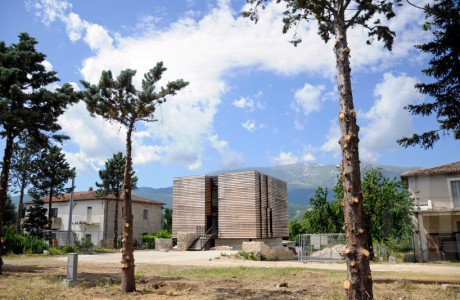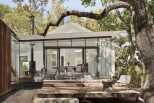A private redevelopment project that wanted to unite contemporary functionality and charm of unspoiled nature. An existing pre cottage…

Using nearly zero energy, this house designed by italian architect Pierluigi Bonomo was built in replacement of a heavily damaged building from the 2009 earthquake in l’aquila, the region of Abruzzo in central Italy. conceived as a volumetric insertion, the ‘energy box’ is defined by its new solid box perimeter. the conservation of the original building is visible with stone traces in the walls on the first level. The new structure emerges from the ground with the reminiscent pieces gradually disappearing, making way for a new physical and symbolic meaning between the heavy memories of the site’s past and the hope for a stable and better future. acting as a mediation between the two elements, the technologically advanced new house is contained within a compact box volume.
 The environmentally efficient building puts minimal demand on natural resources due to cleverly integrated renewable energy systems. Thermal protection in the winter is provided by larch planks on the exterior cladding, high levels of daylight filter through large slits in the south-side – increasing solar gain in the winter, sliding screens also allow ventilation through the building and solar protection in summer.
The environmentally efficient building puts minimal demand on natural resources due to cleverly integrated renewable energy systems. Thermal protection in the winter is provided by larch planks on the exterior cladding, high levels of daylight filter through large slits in the south-side – increasing solar gain in the winter, sliding screens also allow ventilation through the building and solar protection in summer.
 The integration of bio-climatic ‘passive’ strategies and ‘active’ systems helps to reduce the heating demand to 7 kwh/m2year. a photovoltaic ventilated facade,displayed on the southeast elevation, is visually contrasting to the natural wood finish in the planks. paying reference to its past the reuse of demolished materials – stones, steel and wooden purlins for outdoor furnishings and the choice of pre-fabricated construction systems help to minimize energy box’s’ environmental load over the course of its future lifetime.
The integration of bio-climatic ‘passive’ strategies and ‘active’ systems helps to reduce the heating demand to 7 kwh/m2year. a photovoltaic ventilated facade,displayed on the southeast elevation, is visually contrasting to the natural wood finish in the planks. paying reference to its past the reuse of demolished materials – stones, steel and wooden purlins for outdoor furnishings and the choice of pre-fabricated construction systems help to minimize energy box’s’ environmental load over the course of its future lifetime.
(Fabiana Cambiaso – Università La Sapienza)
Energy Box, Aquila (Abruzzo Region), Italy
Pierluigi Bonomo Engineer, Aquila, Italy
Completed: 2013
Materials: Laminated Wood, Masonry, Solar Shading in Larch Wood, Gypsum, Wood fiber, Hardened and Tempered Steel
Applications: Envelope, Structure





